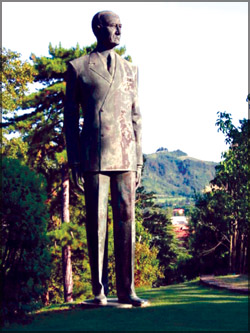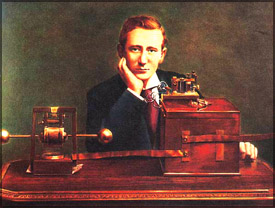|
Guglielmo Marconi:
Initiating communication systems
 We
featured John Logie Baird, the inventor of the television, in our last
In the limelight page. The radio is another medium of entertainment
which is just as popular as the TV. So, who invented the radio?
Guglielmo Marconi, of course. Though best known for developing the
radiotelegraph system, which served as the foundation for the medium of
radio, he has many inventions and patents to his credit. We
featured John Logie Baird, the inventor of the television, in our last
In the limelight page. The radio is another medium of entertainment
which is just as popular as the TV. So, who invented the radio?
Guglielmo Marconi, of course. Though best known for developing the
radiotelegraph system, which served as the foundation for the medium of
radio, he has many inventions and patents to his credit.
Marconi, the Italian inventor, was born on April 25, 1874 near
Bologna, Italy. He was the second son of
|

A statue of John Logie Baird |
Giuseppe Marconi, an Italian landowner, and his Irish wife,
Annie Jameson. He received his education in Bologna, Florence and later,
in Livorno. As a child, Marconi didn't do very well in school.
From an early age, the boy developed an interest in science and
electricity. He began conducting experiments, building most of the
equipment himself at his home in Pontecchio, Italy. His goal was to find
a way to use radio waves to create a practical system of "wireless
telegraphy".
Although many had been exploring wireless telegraph technologies for
over 50 years, none had been commercially successful. What Marconi
managed to do was to assemble and improve an array of facts, unify and
adapt them to his system.
At first, Marconi could send signals only over limited distances.
However, around 1895, with more experiments, he found that he could
transmit signals over the crest of a hill to a distance of 1.5
kilometres. He knew that with better funding and research, the distance
could increase further.
Realising that the scope for his work is limited in Italy, the
21-year-old Marconi travelled to London, England in early 1896 in search
of better opportunities. (Marconi spoke fluent English in addition to
Italian.) There, he gained the support of William Preece, the Chief
Electrical Engineer of the British Post Office.
After a series of experiments and demonstrations, Marconi managed to
transmit Morse code signals over a distance of about six kilometres. The
success of these demonstrations prompted Preece to introduce Marconi's
work to the public at two important London lectures.
Around the turn of the century, Marconi managed to send these signals
over long distances (with the Atlantic Ocean being conquered). Further
tests also revealed that radio signals for medium wave and long wave
transmissions travel much farther at night than during the day.
|

From an early age, he developed an interest in science and
electricity. |
These developments led many inventors including Marconi to build
high-powered stations on both sides of the Atlantic Ocean, to
communicate with ships at sea. However, there were a lot of doubts about
his work with some insisting that he had borrowed from the works of
others and hadn't made much of an original contribution towards the
development of radio telegraphy. There were many patent disputes as
well.
On March 16, 1905, Marconi married Beatrice O'Brien and had three
daughters and a son. They divorced in 1924 and on June 15, 1927, married
Maria Cristina; they had one daughter.
In 1914, Marconi was made a Senator in the Italian Senate, and
appointed Honorary Knight Grand Cross of the Royal Victorian Order in
the UK. During World War I, Italy joined the Allied side of the
conflict, and Marconi was placed in charge of the Italian military's
radio service. He served as Lieutenant in the Italian Army and as
Commander in the Navy.
Marconi joined the Italian Fascist party in 1923. In 1930, Italian
dictator Benito Mussolini appointed him to be the President of the
Accademia d'Italia, which also made Marconi a member of the Fascist
Grand Council. He became unpopular due to these moves and also for
supporting war.
Among the many awards and international honours that he has won are
the Nobel Prize for Physics, which he won jointly with Professor Karl
Braun in 1909, the Albert Medal of the Royal Society of Arts, the John
Fritz Medal and the Kelvin Medal. Marconi died at Rome on July 20, 1937,
aged 63.
As a tribute, many radio stations throughout the world observed two
minutes of silence. His remains are housed in the Villa Griffone at
Sasso Marconi, Emilia-Romagna, which assumed that name in his honour in
1938. Many towns and villages, awards and organisations are named after
him. |
